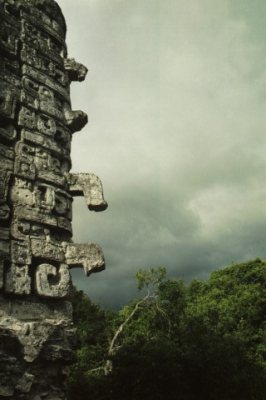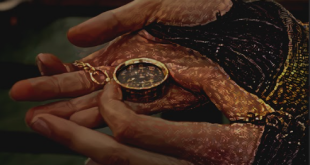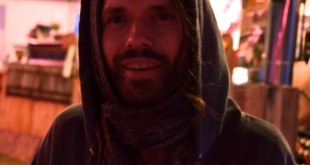© Copyright 2004, 2009 by Jonathan Zap
Edited by Austin Iredale
Disclaimer: Notice the title of this piece is “Vision at Chichén Itzá,” not “Vision about Chichén Itzá.” I make no claim here, as in absolutely no claim, that what I experienced at Chichén Itzá is a revelation of anything about the ancient or modern Mayan people or culture. What follows are a few highlights of my recent trip to Mexico, including a visionary experience at Chichén Itzá.
Tulum, Mexico: September 25, 2004
Yesterday was a blur of travel—all the papers that needed stamping, the waiting in lines, the identity and security checks, the bureaucracy, the seatbelted claustrophobia of confinement to an airborne plastic tube where I breathed recycled air and ate pretzels out of bags of gold mylar, the hurrying through a layover at George Bush Airport in Houston, more pretzels, papers, identity and security checks, another airborne tube, waiting in line to exchange money, filling out papers at the car rental place. Then, suddenly, all that paperwork, bureaucracy, and canned air had somehow resulted in our being in the tropics; we were stepping out of the airport in Cancun, catching the tail end of a magnificent tropical sunset. The humidity in the air was rainforest musk, and birds were singing songs of exaggerated parrot colors in the trees, singing more than I expect birds to sing at sunset.
We loaded our belongings and our selves into a traditional Mayan conveyance, a Caravan, actually a Daimler/Chrysler Voyager, silver, slope-nosed, futuristic-retro-art-deco, a German-American attempt to give a minivan the Weimar Republic art deco feeling of say the first class smoking lounge of the Hindenberg.
With the Hindenberg cocooning us in air conditioning and grey velour upholstery, we blasted down a rain swept highway as heat lightening, then lightening-lightening, lit the sky with flashes of color. It was tropical lightening, which had more color than regular lightening. Everything seemed to have more color than expected, even at night, an extra color effect that seemed feral, possibly illegal in some way, even florescent lit stores were painted in the pastel colors of sidewalk chalk.
At Tulum we stopped and found a hotel which seemed this rainy evening to be far more popular with insects and geckos than people. Many more geckos than gringos, I noticed, and the geckos seemed to have a snobbish dislike of anything horizontal. They had no patience for us slower, less sticky-footed mortals and pale-skinned hominids, and seemed always to be scurrying across the pasteled stucco walls.
Every detail of the hotel insisted on its Third-World otherness. Room keys pulled from a chaotic jumble on a dusty shelf, thousands of details in hilarious contrast to the corporate franchise hotel code of sterile cleanliness and extreme regularity. This was more like my Westernized concept of a hotel reimagined under the influence of tequila and peyote in a parallel universe where geckos ruled the hotel world, not cleaning solvents and deodorizers.
After securing our rooms, we walked down the main drag of Tulum. The storefronts evoked the bodegas of my native Bronx, and if I squinted hard enough I could almost dupe myself into believing I was back on the streets of my childhood. But those were transplanted New York Hispanic places, and these were tropical Hispanic shops, razor wire and metal shutters replaced by pastel colors and life spilling out onto the street, life that seemed unencumbered by rules and anxieties.
Every cell in my body felt the massive, massive drop in neurotic tension, a tension that’s hard to notice in the States, just as it’s hard for a fish to notice water, but the absence of it was almost hallucinatory, a level of naturalness and relaxed participation in life that was refreshingly new and invigorating. And yet the profusion of unrepressed life felt almost illegal, a flaunting of aliveness that seemed like a dangerous provocation of right wing Christian Fundamentalist Republican police forces of some sort which might come racing across the border to bring it under adult supervision.
But at the moment, that didn’t seem to be happening. There seemed to be a surprising amount of unsupervised Mexicans in Mexico, as well as a surprising and delightful lack of U.S. Government officials. Were they for us or against us? Kind of hard to tell. I could have relaxed into this uncertainty more except that I felt that this abundance of unsupervised life must be tempting some sort of preemptive response from the Bush administration. But for some reason, no preemption or supervision seemed to be crashing the party. Maybe the U.S. was so tied up with Afghanistan and Iraq that it had no resources left over to deal with all the shocking profusion of uncontrolled Mexicans in Mexico.
An equatorial sun lighted the next morning, and the reality of Mexico seemed more substantial. Jet travel, which gives you no sensory impact of intervening distance, is so disorienting, you sit in a plastic tube for a few hours, eat a few pretzels, hang out in a completely corporate-controlled canned air environment, the CEO of Continental airlines on a six inch LCD monitor telling you how much the Continental Airlines family welcomes you on board and all that, and suddenly you are in a massively, massively different place—-different air, language, money, smell, taste, sunlight, humidity, and it takes a while for your reality testing to catch up, to realize that the Mexicans were no longer the illegal aliens, now we were the aliens, aliens washing up on the shore of Planet Mexico.
Toast and coffee grounded me to the mundanity of a nutritionally bankrupt breakfast as John related an interesting dream where he was haunted by a mute little Mexican girl who appeared to have Downs Syndrome. She seemed to be from the realm of the previously living and was the latest in a series of parallel dreams that John had experienced during other trips south of the border since the Eighties. As we explored the dream, the breakfast table became increasingly littered with toast crumbs, coffee cups, and Mexican coins, all lit by an orangey-yellow tropical sun. The table seemed like a Mexican collage and I took a picture of it.
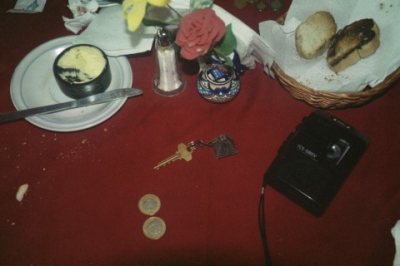
After breakfast we bought limes, snack foods, and many gallons of Electro-Pura brand bottled water. Then we boarded the Hindenberg and drove a short distance to the ruins at Tulum.
This might be a good time to tell you about my three traveling companions. John Jenkins and Sean Moffitt I had both known for almost ten years, had met both of them in 1996, a few months after moving to Boulder. I met John through the late Terence McKenna who was in Boulder for a few days in May of 1996. (see A Mutant Convergence—-How John Major Jenkins, Jonathan Zap and Terence McKenna Met During a Weekend of High Strangeness in 1996 )
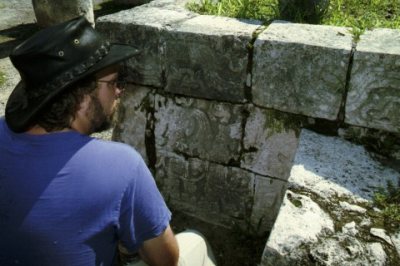
John Major Jenkins
Terence’s theories have parallels to my work and different parallels to John’s research into the ancient Maya. Both Sean and I worked for Greenpeace and later the Prairie Wind Animal Refuge and Colorado Wilderness Experience.
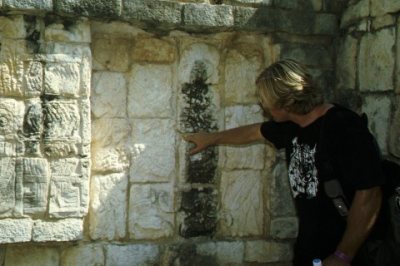
Sean
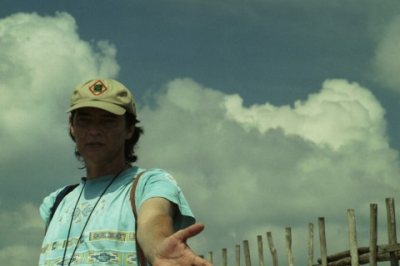
Jim
Jim Reed I had never met before. He looked like a cousin of Antonio Banderas, had been John’s traveling companion in earlier Mayan adventures, and had prepared an incredibly detailed and efficient itinerary for us. After the first day or so I began to realize that everyone except me was an intensely qualified guide, and that I was quite possibly the most well guided person to ever travel to Mayan ruins. John had published ten books related to the Maya, and had revolutionary insights into their cosmology. Jim was the President of the Institute of Mayan Studies in Miami, fluent in Spanish, had spent ten years south of the border, and had the social skills, charm and connections to talk his way into and out of almost any situation.
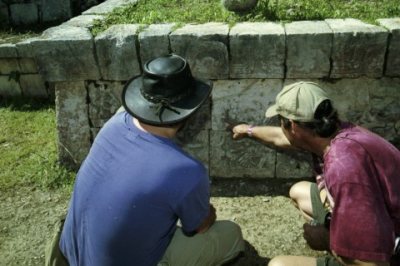
John and Jim
Sean was about as ignorant of Spanish and Mayan studies as I was, but he is a world class naturalist and tracker, and although inexperienced with tropical flora and fauna, was able to notice and point out all sorts of fascinating things happening in our natural environment which might otherwise have been missed.
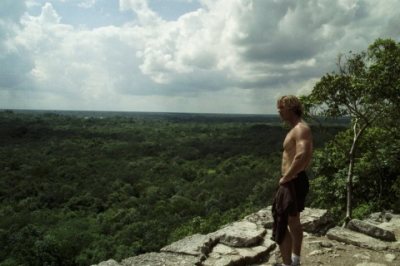
Sean
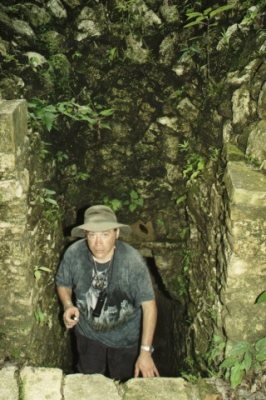
Jonathan
As the four of us hiked into Tulum, I began to realize the vast amount of Mayan ruins, much of it mounds of stone in the jungle that no one had gotten around to digging out. What we saw was just a few ruined highlights of what had been thousands and thousands of square miles of ancient civilization.
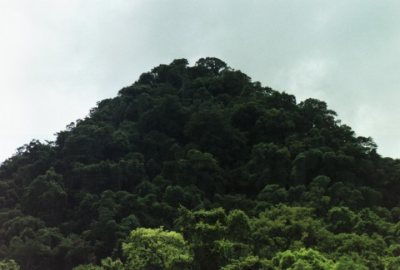
Unexcavated Mayan Pyramid
Tulum was set in tropical paradise, blue Caribbean water and sandy beaches bordered by coconut trees. Iguanas sunned themselves on stone columns and blocks of stones still bearing Mayan glyphs.
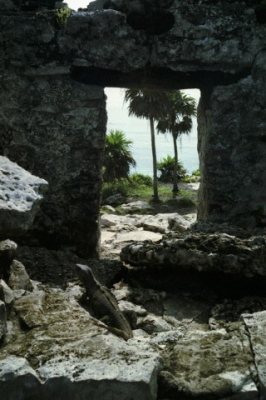
We swam in the warm tropical ocean, and when we looked back toward shore the Mayan ruins rose out of the jungle all around us.
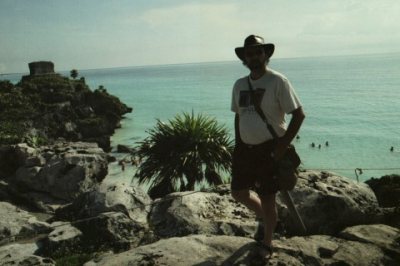
John
The tourists that were there were mostly Spanish speaking and didn’t seem to violate the setting the way some American tourists do. One American tourist I did see was a man in his early thirties, and a certain narcissistic assertion about his every mannerism and dress, which would scarcely have been noticeable stateside, stood out here in sharp relief, his egoism sounding in waves of brassy percussion a dissonant note in the tropical air.
There was too much to experience for me to journalize most of it. What I am presenting here are a few tiles in a giant mosaic of impressions.
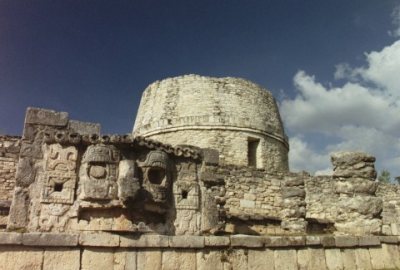
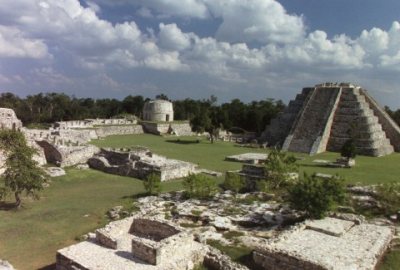
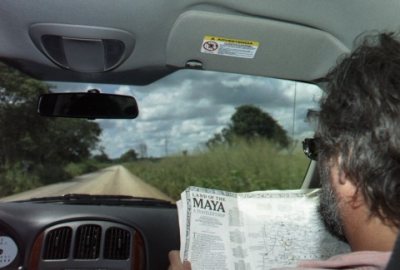
A few days later we worked our way across the plaza of Edzna, a Mayan site that had been occupied since 400 BC, but abandoned by 1500 AD. The thermometer I had with me registered a temperature of 105 degrees Fahrenheit (40 Centigrade) after sitting in the shade for ten minutes. 100% does not seem like a sufficient superlative to describe the humidity. Is it possible for humidity to be more than 100% without actually being underwater? Mosquitoes were constantly extracting a blood sacrifice, and Jim told me that, according to Mayan mythology, the mosquitoes had done a service for Hunahpu and Xbalanque in the underworld and that entitled them to feed on our blood. “But what have they done for us lately?” I wanted to know.
In the evenings, John and I would sit in the public squares of various towns we stayed in. People were always about in these squares, hanging out, kids kicking soccer balls, couples, families, an intensity of civic life that seemed very other. It seemed like no one had taught these people that they were supposed to be home watching DVDs and congregating online.
Some towns seemed much happier than others, and in certain parts of the country everyone seemed depressed, sullen, lethargic. Everywhere we traveled we got intense stares and it was a chance for me to feel the energetic effects of raw projection. In Boulder I might get the occasional projection of someone picking up something faintly weird about me, an obsessed looking character with an extremely weathered and mutated camera bag, but here I was apparently seen not as a mutant but as an icon of wealth and privilege, and many eyes flashed with volatile mixtures of curiosity, resentment, envy, longing, and anger. No one I encountered seemed to carry the genius of the ancient Maya. I wanted to see a Mayan shaman with a thousand year stare contemplating galactic alignment, but everyone I met seemed more caught up in the life of 2004 Mexico than in 26,000 year cosmic cycles.
Two or three days into the trip, walking through a tropical forest somewhere, we met an attractive and interesting twenty-five year old Belgian woman named Griet who worked as a teacher in London, and she traveled with us for several days.
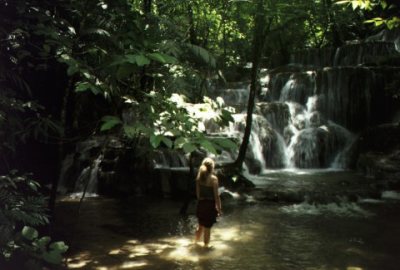
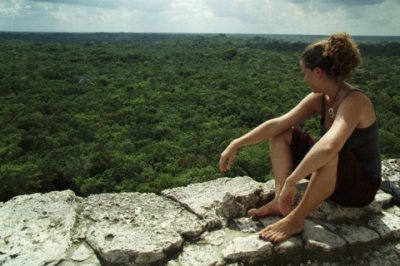
Griet (and above in tropical forest)
I remember her being with us when we descended into an amazing cenote (cenotes are deep water-filled sinkholes formed by water percolating through soft limestone). There were great chambers of glittering stalactites and a deep pool of absolutely clear water, fairly warm, which we were able to swim in.
I’d never swam in a cave before, and the experience seemed quite magical and archetypal.
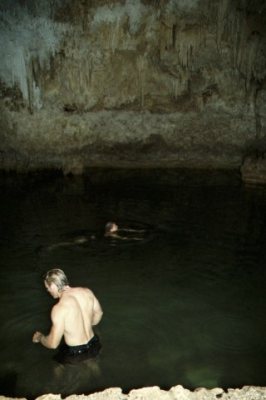
Sean, Griet
While we swam there were a series of thunderous reverberations traveling through the stone. As it turned out it was actual thunder, and suddenly the foliage-framed aperture at the top of the great chamber in the cenote, which was also our exit, flooded with an explosion of rainwater.
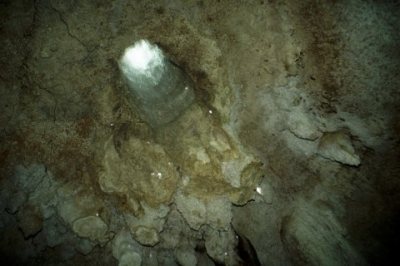
Another day we descended into one of the greatest known caves on the planet, Loltun Cave.
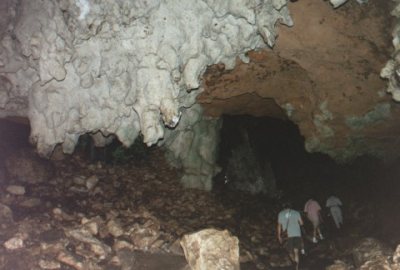
I had previously done only one serious spelunking adventure and had toured lots of caves, including Mammoth Cave in Kentucky, but nothing prepared me for Loltun.
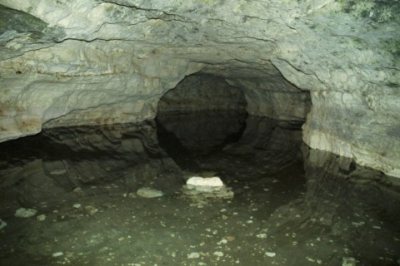
It was an underworld descent in more ways than one as our guide, once we were actually in the cave, ran a bit of a scam on us, revealing new fees that had not been disclosed topside. But it was worth the extra pesos, especially since we had the cave all to ourselves. The chambers were massive, gigantic, sometimes three hundred feet high, an inhuman scale that projected the scary feeling of massive industrial power, as if we were inside the mutated concrete sarcophagus of a Chernobyl reactor tower or the inside of an H.R. Giger extraterrestrial vision. Above our heads were vast upside down landscapes with mountains and canyons and infinite detail and surface texture. The most memorable of these was an upside down planet of bats, a sulfurous yellow planetscape that evoked Dune’s Arrakis, the desert planet. It had giant craters filled with spherical sleeping bats. There was a butte that rose out of this desertscape that was the exact color and texture of desert-scorched bone.
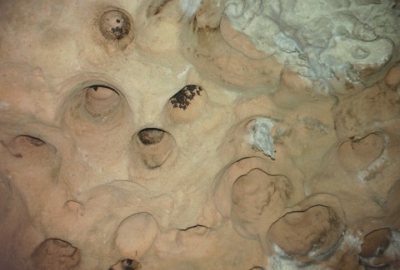
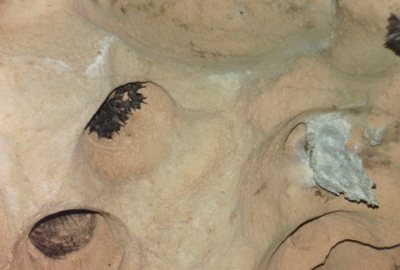
Flying bat, upper right
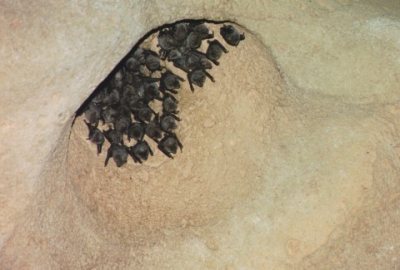
Deeper in the cave were artifacts left by prehistoric humans.
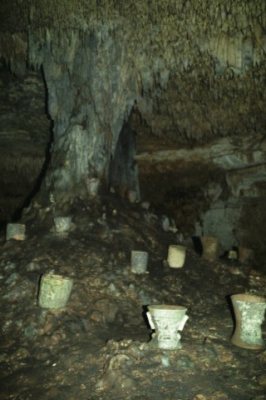
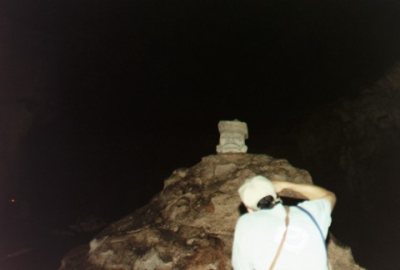
Loltun Cave had been a butchery for Ice Age fauna, and there was Mayan cave art from the Paleo-Indian period of Mesoamerican prehistory. Apparently this is the only prehistoric cave art that the public is allowed to breath on. As I stood before it, I felt like I had wandered into the deepest and darkest recess of the human past.
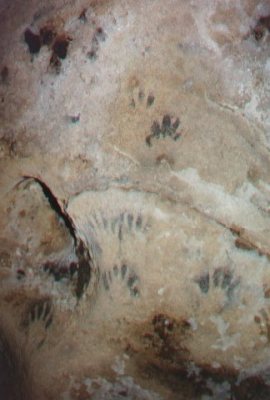
Caves are natural time capsules, and these paintings looked like they could have been made yesterday. I felt like I had wandered into the deepest darkest recess of the human past, which felt like it was unstuck from time and here right now.
On the morning of the 27th I awoke from a dream with a statement in my mind, something I had just told a dream character:
“Never underestimate the power of a ritual created spontaneously in the moment with pure intention and intensified through repetition.”
Strange effects were happening to me, but what to attribute them to? The Mayan ruins? The heat? The humidity? The margaritas? Internal cycles and perturbations? All of the above? Intense changes in my relationship with the hyperspatially existing companion that lives alongside of me? I never know quite how to describe this without sounding like a goofy New Age channeler or a schizophrenic who needs his meds adjusted. This companion came into the foreground of my awareness and stayed there for much of the trip, his presence far more physical, immediate and dynamic than usual. There were many changes in the relationship and new developments, and I had to divide my attention between my awareness of this companion and of my corporeal traveling companions trading places in the foreground or background as the need of the moment required. Multiple streams of often dissonant realities poured into my perception—the companion relationship, the tensions and camaraderie of the traveling group, doing I Ching readings and counseling with John about drastic personal shocks he was experiencing in his life back in the States, the world of modern Mexico and interactions with Mexicans, their projections and my counterprojections on them, the flora and fauna of the tropics and the new flora and fauna in my gastrointestinal tract, the power and otherness of the remnants of Mayan civilization, the practical details and logistics of Third-World travel, seeing the world through my eyes, the companion’s eyes, and much of the time seeing it through the viewfinder of my camera, concentrating on the composition with one eye, another eye keeping track of my traveling companions so I didn’t get lost, and at the same time trying to keep eyes in the back of my head so somebody didn’t yank my camera.
Emerson said that, “The problem with traveling is that you take yourself with you.” But that’s also the potential magic and transformative power of traveling too. My strange inner contents were hybridizing with the strangeness around me, and inevitably inner and outer became a blurred distinction. Which weirdness was mine and which was Mexican? Which Mayan? Which came from the other people in the minivan? And if that weren’t enough, I spent large parts of each day obsessing about the impending presidential election, even had dreams about it, Kerry vs. Bush, the first debate to happen while we were in Mexico. I did readings on it and rituals to help Kerry while we stayed in Palenqué at an inexpensive but amazing little resort in the rainforest. There I realized that one should never underestimate the power of a ritual created to undermine Bush, created spontaneously in the moment with pure intention and intensified through repetition. I wanted Bush to fall apart in the debates, wanted Kerry to be the dragon-slayer. I wanted him to stick a javelin made of Elvin Silver-Steel into the heart of the Great Orc, or the son of the Great Orc, or whatever Bush is. I wanted to break into the tomb in the Skull and Bones clubhouse at Yale, and see if shape-shifting Reptilians ruled the world or only David Icke’s imagination. I wanted to see even an hour’s worth of Mayan civilization happening in real time right now, wanted to see what all those pyramids and observatories looked like when they were freshly painted in tropical color.
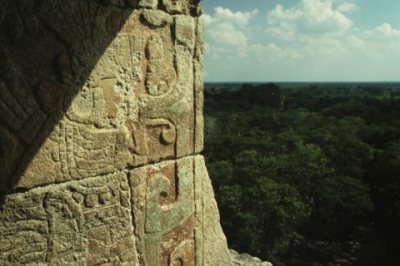
A remnant of the original colored paint remains on these carvings.
What did those ancient Mayan cosmologists really have in mind when they ended their long count on December 21st, 2012? Do we have to wait till 2012 to be rid of the Bush crime family? Will Jeb take over for Dubyah in 2008 to make sure that by 2012 we will all be begging for the world to end? Is our whole civilization a giant costume malfunction waiting for an asteroidal Justin Timberlake to expose us as the most toxic, silicon-inflated and unattractive of ruined civilizations? Are we just asteroid bait, begging, baiting Gaia to shock and awe us with an overdue preemptive strike?
These are only a sampling of the sort of apocalyptic rhetorical questions that haunted my margarita-addled imagination.
So much was happening inside of me that by the morning we got to Chichén Itzá I was already jaded by ancient ruins. Ancient ruins were getting old, you might say. They were history, but the air conditioning of the Hindenberg was what was happening now and it was becoming numinous, was beginning to glow, beginning to loom larger and larger in my mind like a great ring of power. Mayan cosmology seemed a bit of an abstraction; what had it done for us lately? How could the completion of a great cycle of time in eight years compare with the revitalizing power of air conditioning that when cranked all the way up felt like the breath of a goddess awakening me from the lethargic nightmare of extreme and abusive heat and humidity? Nietzche said that, “If there are gods, how could I stand it to be no god?” I say that if air conditioning is a goddess, how could I stand it not to be embraced by such a goddess?
Driving toward Chichén Itzá I was embraced by the goddess Air Conditioning, who held me in her swirling arms, washed clean the sweat of my misery, and lifted me from mundanity like the smoky, ephemeral dream of an opium smoker. I had no reason to expect more of Chichén Itzá than any other site, and as we approached it I saw that, more than any other site, it was preceded by the most cheesy and touristy of sunfaded, sidewalk chalk painted souvenir shops, streamers of plastic flags, and Mayan deities rendered in every shape and color that the genius of plastic makes possible.
Then, rudely disgorged from the loving embrace of the goddess Air Conditioning into the blooming, buzzing nightmare of extreme humidity, we approached Chichén Itzá through a gauntlet of snack bars, milling tourists and turnstiles—we might as well have been approaching the Third-World equivalent of Space Mountain. And what kind of a name was “Chichén Itzá” anyway? Sounded like Spanish for chickens infected with chronic eczema. In my mind it conjured images of itchy chickens running demented circles in the hot dust, chickens that had never known air conditioning, chickens that were only too glad to be sacrificed.
Fortunately we were past the peak tourist season and what had been made to accommodate thousands, now accommodated only a few hundred, and no one pressed around us as we walked a long gravel trail toward the site. What did try to press toward me was a negative thought form, an anxiety-tinged tape loop about an unresolved matter back in Boulder that had a strongly negative emotional charge. In recent years I have become much more resistant to such tape loops and have greatly benefited from a set of techniques for dealing with them (see “Dealing with Afflictive Thoughts and Feelings” in A Guide to the Perplexed Interdimensional Traveler ) Thought forms sometimes seem to have a life and infectious intention of their own, and sometimes may be the attack of “mind parasites” (see Mind Parasites, Energy Parasites and Vampires) those thousand pale scorpions that sting us with fear and poisonous anxiety in our most vulnerable moments.
And so, hiking toward the site, I felt one of these hot, sticky parasitic thought forms trying to press into my space like a drunken pervert with an erection trying to rub against me in a crowded subway. But before I could resist it using my usual techniques, something happened, some energy or will seemed to give my ordinary resistance a gigantic power, and I first experienced this power as a hypnogogically intense visualization of the mind parasites. Ordinarily they were vague, flickering, hiding in the shadows of my mind. Now they were visualized in startlingly sharp relief, the way a bolt of lightening on a moonless night can for a moment reveal in infinite detail a hidden landscape.
What I saw was a vast army of clowns with empty eye sockets coming toward me. They all did a jerky mechanical dance and they had big floppy powdery-white organic ears, like elephant ears, and the white powdery ears seemed like layers of talcum powder covering cancerous tissue metastasizing with malignant lesions beneath the white powder.
No, I don’t think this is what mind parasites really “look like.” They are shape-shifters. Their form is legion. Like the devil that has the power to assume a pleasing shape, they have the power to assume unpleasing shapes, and the mind’s eye also has the ability to visualize them in unpleasing shapes as it scans them immunologically with psychic radar. This visualization revealed them as hungry ghosts, what the Buddhists call “pretas,” the disincarnate remnants of departed human beings that seek to feed off of living human vitality. And then, after a few lightening flashes of vision revealed this blind, mechanical army of hungry clowns, a gigantic force seemed to energize my resistance and a burst of fire came out of me, as if I were a giant flame-thrower, and the army of clowns were incinerated in one breath of fire, and all that remained were a few glowing cinders swirling in the air which in a moment vanished to nothing.
Their form had been incinerated, but not their hungry, ravenous will, and in a few more moments they reconfigured themselves and appeared in a form that could not be so sharply visualized. Now they were airborne, a cloud of giant mosquito-like insectile forms blurred with speed, faster than fighter jets, exploding toward me. Once again I felt a gigantic, seismic force or will supporting my resistance and another burst of fire exploded outward incinerating the flying horde of ravenous parasites.
This all happened while we were on the gravel path. I hadn’t even seen the site, and at that moment did not attribute it in anyway to Chichén Itzá. Since I am obviously no stranger to internal weirdness, why should I have sought an outward cause? And from the great principle of logic, Ockham’s Razor, which says that hypotheses should not be multiplied without necessity—in other words, don’t seek a fancy, complicated explanation when a simple one will suffice—to view this occurrence as more than an internal perturbation would only be an open invitation to be deceived by the million masks of projection. That’s why I put a gigantic disclaimer at the beginning of this document. What I can attribute to myself, and what, if anything, I can attribute to Chichén Itzá about this mind parasite experience I cannot definitively say. What intuition does assert, however, is that Chichén Itzá is a power spot, a window zone, a place, like Monument Valley, where reality is configured differently, and which, like a great spirit medicine, has a certain character, but may effect one person very, very differently than another person.
On the trail walking toward the site, I didn’t associate my experience with Chichén Itzá. But sometime after, maybe when we were first approaching the great Pyramid of Kukulkan, I became aware that behind my enhanced will to resist the mind parasites there had been a gigantic pulsation of power. It was a pounding deep, deep bass note, and that deep bass note persisted, had a definite periodicity, and seemed to emanate from this specific zone of space-time.
In my awareness of Chichén Itzá as a power spot there was a definite boundary of demarcation, a place where the power intensified and became unmistakable. This boundary or point of intensity came well after we had climbed the great pyramid. It came as we approached the Sacred Cenote of Chichén Itzá, which appeared as a gigantic pit or concavity in the earth, deep water obscured its bottom (so far no one had been able to reach the bottom of its murky depths) and the walls of the pit were riddled with caves and grottos partly hidden by tropical vines and foliage.
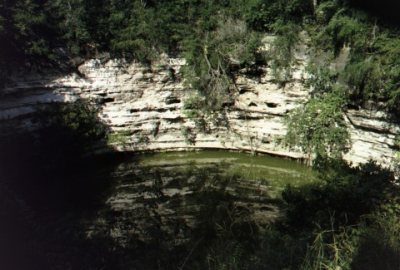
Historically this was a pit of no escape and sacrificial victims were apparently tossed in there to drown. Dozens of skeletons have been dredged from the pool or found in its caves and recesses. I couldn’t tell if the power I felt was a resonance of the sacrificial rituals, preserved in eternity like a mosquito frozen in amber, or if the Sacred Cenote, like Monument Valley, was a place of great geophysical power, a power spot recognized by ancients who built a site around it and developed ritualized interactions with it.
Intuition tells me that the Sacred Cenote is a confluence of both factors. Places where traumatic events have occurred, where human blood has been spilled, murder sites, battlefields, do seem to remain haunted by a time-spirit or resonance of their past. And aside from any human effect, if Gaia is an organism, a spherical body, as British biologist James Lovelock demonstrates, then all portions of the surface of that body are obviously not the same. All portions of the surface of our bodies are not the same in their sensitivity and energy. It is very different, for example, to have a mosquito land on your elbow than to have it land on the cornea of your eye. Monument Valley has the feeling of an organ of energy on the body of Gaia. Some have compared it to the endocrine system. Whatever it is, it is not subtle. It is a place where intensity is concentrated, and anyone with an ounce of sensitivity must feel and recognize it as the Anasazi Indians did. Before an ancient, cosmically attuned civilization invested a billion man-hours of labor to construct a Chichén Itzá, you can be sure that the plan began with something more than a casual “might as well be here” intention and recognition of place.
Every cell in my body screamed that the Sacred Cenote was an orifice of power, and one glance at Sean told me that he was being drastically affected as well, though I haven’t investigated his inner experience, as I didn’t want our imaginations to confabulate.
Jim mentioned something about a ritual conducted here where there would be one fire, and no other fires were allowed, and this resonated with my feeling of the place as a point of concentrated power. John pointed out that we were at the same 19.5 degree latitude where most hurricanes form out in the Caribbean, and at the same latitude on the planet Jupiter was its great red spot. I thought of the Tolkien mythology and some of Tolkien’s notes about the difference between Morgoth and Sauron. Morgoth was the original evil being whose will had been involved in the creation of all of Middle Earth. All of Middle Earth was Morgoth’s Ring as Tolkien described it, his power pantheistically distributed throughout the entire realm. Sauron was his disciple, a being of lesser power, but Sauron’s power was far more concentrated, concentrated especially in the One Ring. Sauron therefore had more useable and potent power than Morgoth since his power was concentrated and one-pointed like a laser beam. Intuitively, I felt that the ancient Maya, and some other ancient peoples knew and used this principle of concentrating power, and Chichén Itzá was a living embodiment of that principle.
Standing before the Sacred Cenote I had some intuitions about blood sacrifice that I discussed with John (but please do not hold him responsible or assume that he approves of these ungrounded speculations. Do read his books for grounded, carefully researched material on the Maya). John pointed out that it was the winners of the Ball Court game that were sacrificed, that it was considered an honor. I wondered aloud if the ancient Maya might not have worked out a more clever symbiosis with the mind parasites, gave them a more conscious and intentional feast and perhaps this contained their infection, kept it from being as pervasively distributed as it seems to be in our culture. It suddenly occurred to me that all the bloodletting that European physicians practiced for about 1,800 years might have been an unconscious propitiation of the parasites. Remember that doctors used to be called “leeches” because their universal treatment was to apply leeches to patients to bleed them. These treatments were perfect nonsense, had been handed down from the Greek philosopher Galen, and it wasn’t until the 1860s that it was discovered by an obscure British physician that the form of medicine taught in the finest Schools of Europe and America had been killing people for 1,800 years! (For more on this see The Glorified Body.) Many of the greatest names in history were bled to death by their doctors including a guy by the name of George Washington, whose doctor, treating him for a winter cold, relieved him of six pints of blood. George Washington’s last words were to his physician, “Pray, take no more trouble about me; just let me go.” Who was all this unconscious blood sacrifice for? It certainly wasn’t for the patients. Be wary of Westerners who think of the ancient Maya as barbaric for their relatively few sacrifices when we are from a culture that burned six million women as witches during the Middle Ages and six million Jews in living memory. Perhaps the Maya were far more humane and efficient in their bloodletting.
Consider the refrain of the Eurthymics song, “Some people want to abuse you, some people want to be abused.” Well, some people want to devour you, and other people want to be devoured. You’ve probably heard about the high profile trial this year in Germany of a modern cannibal. An educated, middle-aged German man wanted to be a cannibal, and he advertised on the Internet for a willing victim, someone who wanted to be devoured, and he found a volunteer. The trial was to decide if he should be convicted of manslaughter for an entirely consensual act. There is a lot about the active and passive faces of human bloodlust that we know nothing about.
Somewhat dazed, I followed the group away from the Sacred Cenote, and in a few hundred yards found one of the most surreal sights I have ever seen. No, no, I couldn’t possibly be seeing this; this cannot be real, I thought. But there it was, there before me was a . . . snack bar . . . This was like finding a snack bar just outside the gates of hell…this couldn’t be happening… people drinking Gatorade and eating pretzels beside a giant orifice of deadly power.
John was keeping track of the time and the position of the sun, and he led us back to the great Pyramid of Kukulkan to see something.
In my whole body I felt that deep bass note, a pounding drum-like reverberation of power, a feeling of gigantism, power that in my psyche manifested as a will to fight the mind parasites. And this feeling of massive power was not a chimera flickering through my mind. It was a feeling in the gut, a feeling in the second chakra, the survival chakra, and as we walked past massive blocks of stone covered in glyphs I perceived that this site was a massive engine of power and information, that this was a place made of language. It was an illuminated alchemical manuscript like the Zohar, the classic Cabalistic text, but this manuscript was wrought in a billion tons of stone, a manuscript made from the bones of the earth. Words or spells of fell power seemed to rise up and hang in the air, outweighing the dense humidity. I felt my circuits overloading with a massive, massive download of information and potent energies. Phrases formed in my mind like, “The strange persistence of a language of power.” Magical thought forms, words of power seemed to be encoded here hyperspatially, in the realm of pure form, the morphogenetic field, persisting in this zone across eternity. But they had also been concretized, massively anchored in stone that was also persisting through the centuries, surviving the rot and organic riot of encroaching jungle.
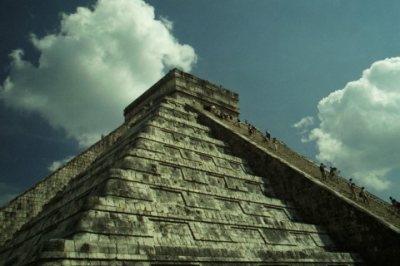
The Pyramid of Kukulkan loomed massively into view, and then I saw it, the reason we had timed our journey to happen in late September. At the base of the pyramid was the gigantic stone head of a serpent, and a gigantic tail, composed of triangles of reflected sunlight and shadow, formed all the way to the top of the massive structure.
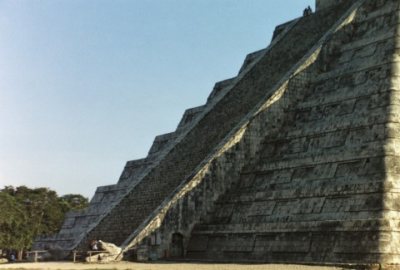
I beheld a living, illuminated rune or glyph of power, a thought form, anchored massively in stone, a marker of cosmic cycles created by the ancients and still functioning, standing gigantically before me and marking the autumnal equinox of 2004 AD.
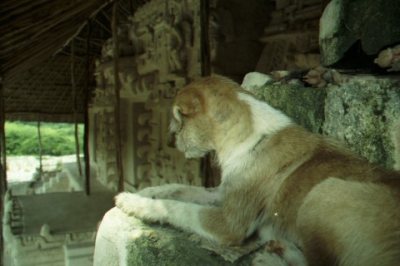
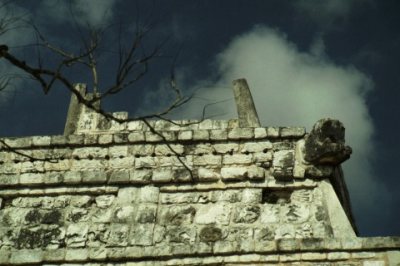
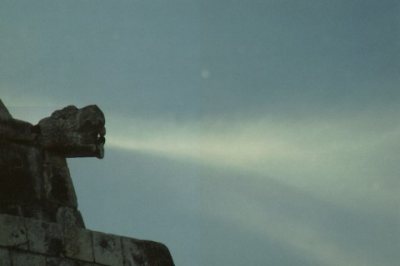
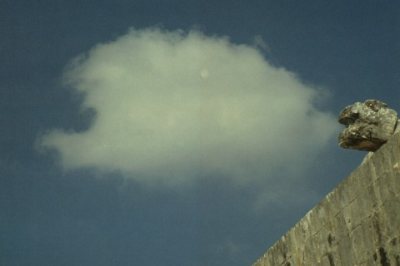
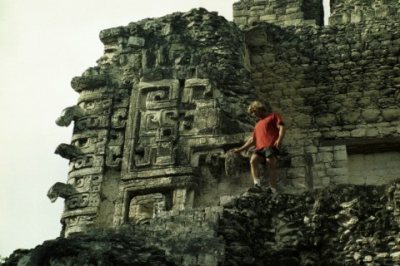
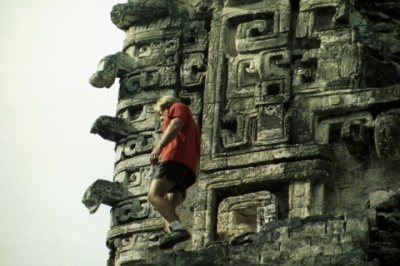
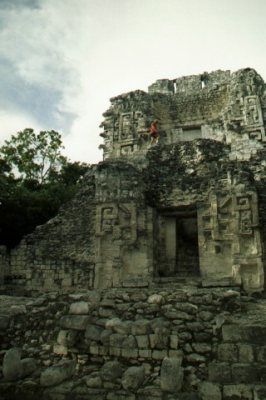
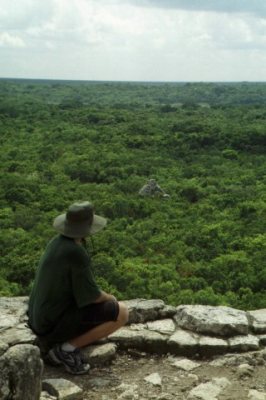
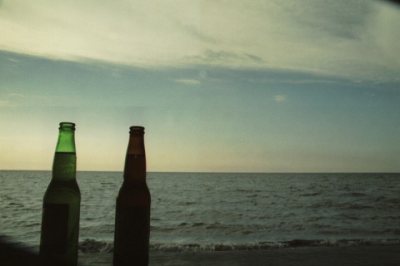
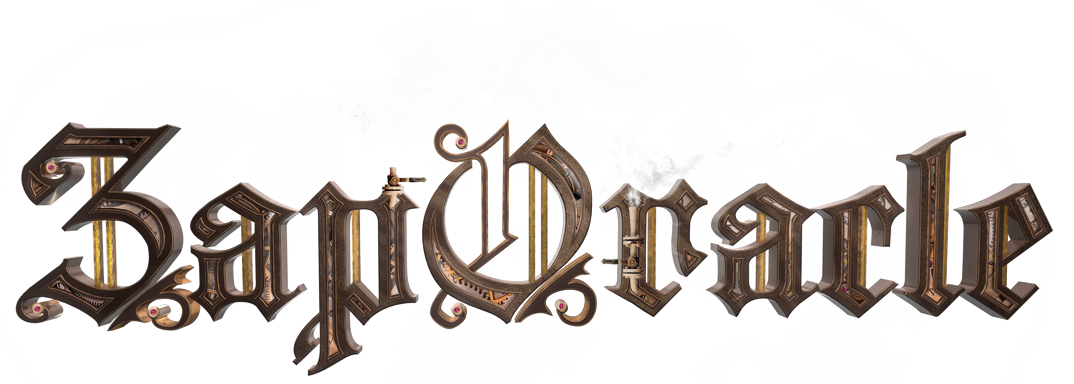 ZapOracle.com home to the free 720-card Zap Oracle
ZapOracle.com home to the free 720-card Zap Oracle

